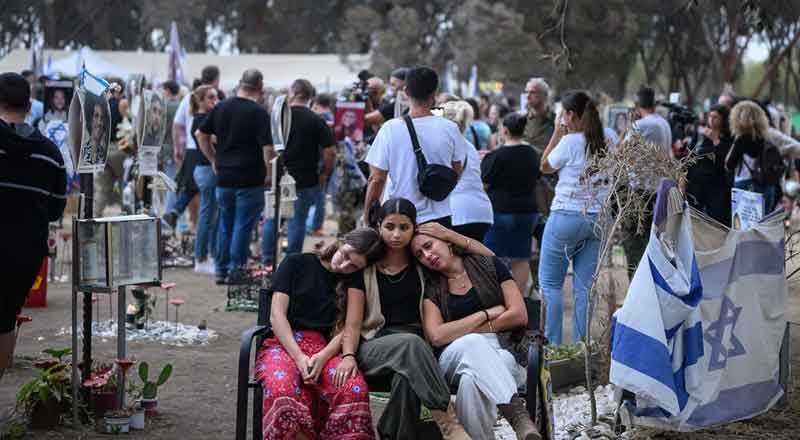- Hostage families gather outside PM Netanyahu’s house
- Ceremonies to take place at Kibbutz villages and towns
- President Herzog presides over memorial at site of music festival
- West Bank movement restricted, many checkpoints closed
One year after the devastating Hamas-led attack on Israel, the country finds itself once again in the grip of war, facing threats from both its southern and northern borders. The anniversary of the October 7, 2023 attacks, which left 1,200 Israelis dead and took 250 hostages to Gaza, is marked by nationwide ceremonies, heightened security, and a reflection on how the events of that day have shaped Israel’s current military and political landscape.
Remembering the Tragedy: A Day of Mourning and Reflection
At exactly 6:29 AM on Monday, October 7, 2024, Israelis paused to remember the moment when the horror began. It was the hour when rockets fired by Hamas militants from Gaza rained down on Israeli communities, signaling the start of an unprecedented assault that would become one of the deadliest days in the country’s history.
In Jerusalem, outside Prime Minister Benjamin Netanyahu’s residence, families of the 250 hostages taken in the attack gathered with hundreds of others to honor the victims and protest for the safe return of their loved ones. As sirens echoed through the city, they held up pictures of those still held captive in Gaza, including children, women, and elderly people.
Meanwhile, at Reim, where over 360 people were killed at a music festival during the initial onslaught, Israeli President Isaac Herzog led a solemn memorial service. The ceremony began with the last song played at the festival, a poignant reminder of the sudden violence that interrupted what should have been a day of celebration.
Across the southern border, in kibbutz villages and towns that bore the brunt of the October 7 attack, similar ceremonies unfolded. These regions, once peaceful agricultural communities, now stand as symbols of resistance and survival.
High Alert and Escalating Violence
While Israel reflects on the loss and trauma of the past year, the present conflict looms larger than ever. Security forces were on high alert across the country, anticipating potential attacks from Palestinian militants marking the anniversary. The Israeli military ramped up patrols and bolstered checkpoints, particularly in the West Bank, where tensions remain high. In some areas, movement was restricted, with residents reporting a near-complete lockdown in anticipation of violence.
In Gaza, Israeli forces reported foiling a Hamas rocket attack on Monday, highlighting the ongoing volatility in the region. The airstrikes and counterattacks between Hamas and Israeli forces, which have been relentless since the initial assault, have drawn global attention and concern.
According to Palestinian health authorities, nearly 42,000 people have been killed in Gaza since the fighting resumed. The war has also displaced much of Gaza’s 2.3 million residents, turning an already densely populated region into a humanitarian catastrophe. In response to these figures, international protests against Israel’s military offensive have erupted worldwide. Critics point to the heavy civilian toll in Gaza, while Israel maintains that its operations are aimed at dismantling Hamas’ military infrastructure.
Hezbollah Front: The War Shifts North
While Gaza remains at the heart of the conflict, the war has shifted increasingly to Israel’s northern front, where Hezbollah, the Iranian-backed militant group, has entered the fray in support of Hamas. Just one day after the Hamas attack last year, Hezbollah launched missile barrages into Israel from Lebanon, and the exchanges of fire between the two sides have only intensified.
In recent weeks, Israel has expanded its military campaign into southern Lebanon, targeting Hezbollah strongholds and launching a ground offensive in border villages. The aim is to root out Hezbollah fighters, allowing the thousands of Israeli residents evacuated from the north to return to their homes. However, the offensive has triggered a humanitarian crisis in Lebanon, with more than a million people displaced from their homes as the fighting escalates.
The Israeli strikes have already claimed the lives of over 1,000 Lebanese civilians in the past two weeks, and the situation shows no sign of de-escalation. Hezbollah, meanwhile, has responded with missile attacks on Israeli cities, raising concerns of a broader regional conflict involving Iran, Hezbollah’s chief supporter.
The Iranian Factor: Fears of a Wider War
Iran’s growing involvement in the conflict has raised alarms about the possibility of a regional war. In recent months, Israeli forces have conducted a series of targeted assassinations against Hezbollah and Hamas leaders, aiming to weaken the groups’ command structures. However, these strikes have also provoked retaliatory missile attacks from Iran.
On October 1, Israel was hit by a second barrage of missiles from Iran, marking an unprecedented escalation. Israel has yet to respond to this latest Iranian assault but has vowed to take severe action in due course. For many Israelis, this brings new fears of an all-out war involving Iran, a powerful and dangerous adversary.
The delicate balance of power in the region has been shattered, and as the conflict continues to spiral, the prospect of a wider war involving multiple countries—especially Iran—becomes more likely.
A Year of Trauma, A Year of War
The October 7, 2023 attacks shattered Israel’s sense of security, leading to widespread criticism of the government’s preparedness and response. For a nation that prides itself on a sophisticated and well-equipped military, the attack was a devastating blow. The immediate failure to defend its citizens left many questioning the leadership of Prime Minister Benjamin Netanyahu and Israel’s intelligence services.
One year later, the consequences of that fateful day continue to reverberate. With the war now raging on two fronts—Gaza and Lebanon—Israelis are left to mourn their losses while bracing for what lies ahead. As vigils are held around the world in solidarity with the victims, protests against the war and its devastating toll on civilian lives also grow.
As the conflict intensifies, one thing is clear: the shadow of October 7, 2023, still looms large over Israel and the wider Middle East, with no end to the violence in sight.
(With inputs from agencies)





